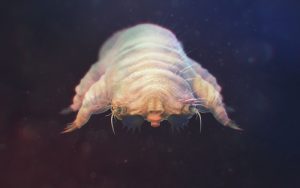Parasites From Birds’ Nests – Advice From the Pros
By Chris Williams on May 7, 2012.
An empty bird’s nest can be more than just an empty bird’s nest. It can also contain parasitic mites, ticks, and fleas, as well as other scavenger insects, especially if it has been recently abandoned by the birds. When a bird’s nest is built on or in a home or other occupied building, those insects and mites can find their way inside and can bite people, or infest other materials.
 Bird mites and other bird parasites don’t normally leave the nest or bite people as long as they have birds to feed on. But when the baby birds leave the nest, or if the birds die, and the nest is abandoned, the parasites often leave too, looking for another host to feed on. Bird mites are the most common of the nest parasites that interact with people. They are barely visible to the naked eye and are yellowish-gray when unfed. Mites that have been feeding on blood may be red or almost black. Bird mites can be easily confused with clover mites (which do not bite) or newly hatched ticks. Even when bird mites wander away from the nest, they are not very likely to bite people, but occasionally do.
Bird mites and other bird parasites don’t normally leave the nest or bite people as long as they have birds to feed on. But when the baby birds leave the nest, or if the birds die, and the nest is abandoned, the parasites often leave too, looking for another host to feed on. Bird mites are the most common of the nest parasites that interact with people. They are barely visible to the naked eye and are yellowish-gray when unfed. Mites that have been feeding on blood may be red or almost black. Bird mites can be easily confused with clover mites (which do not bite) or newly hatched ticks. Even when bird mites wander away from the nest, they are not very likely to bite people, but occasionally do.
In addition to bird parasites, nests often contain certain scavenger insects like carpet beetles, hide beetles, spider beetles, even clothes moths. These insects feed on feathers, droppings, nest material, dead birds, or broken eggs. Some may be in the nests to feed on other insects in the nest. In homes, these same pests can infest woolens, fabrics, furs, hides, and stored food products.
These bird nest refugees are most likely to get inside when the nest is in a vent, under eaves, on floodlights, in gables or an attic, or on a window air conditioner unit. The mites are so tiny that screens won’t keep them out. We get most of our bird mite calls in the spring when most baby birds are born and fledged.
Bird mite numbers can be reduced by thorough vacuuming or picking them up with a damp cloth. A professional pest control company can treat around the nest site to kill any remaining mites. The nest should be discarded in a sealed plastic bag. Be sure to wear gloves and long sleeves if you do this yourself. Prevention includes eliminating the nest site by screening or sealing openings or otherwise altering the building so that birds can’t nest in that area again. At Colonial, we’re experts in bird control and bird-proofing. Our technicians know how to keep nesting birds off of your home. Give us a call.